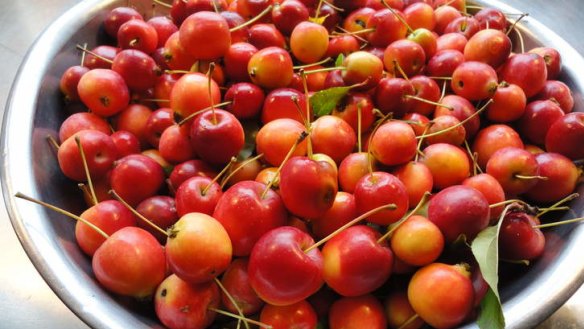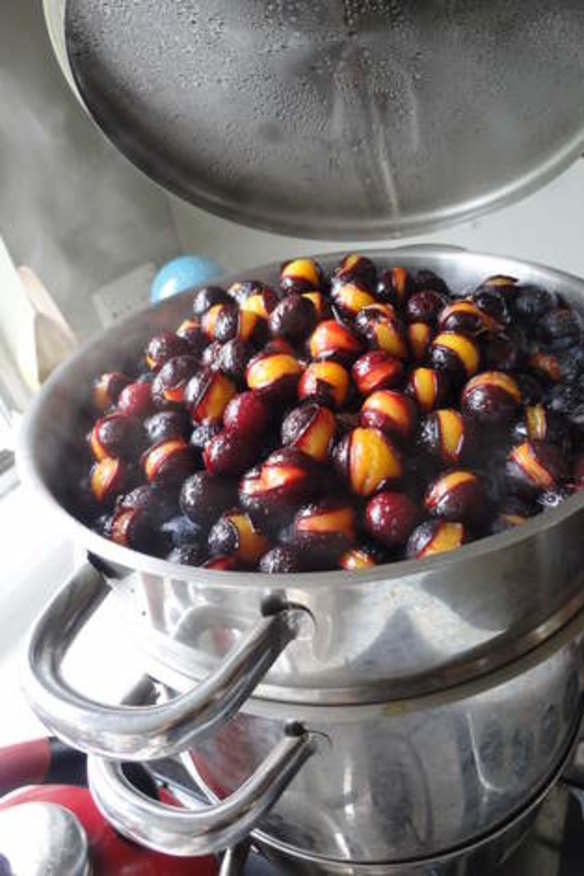Jelly express going full steam ahead

I have a funny contraption that has been getting a workout lately. It looks like a triple-decker saucepan that sits on the stovetop. It is called a juicer steamer.
The fruit goes in the top perforated section, so the juice can fall through to the middle section. I fill the bottom with water and boil it for a couple of hours. Eventually, the water boils away and the juice is collected. Juicer steamer sounds like an odd name, but that is exactly what it does, extracting juice by steaming.
I have come across lots of excellent jelly-making fruit lately, which led to a bout of steaming frenzy. I was lucky to get some damson plums, quinces and crab apples. I bought the organic plums and quinces from Jonathon and Robyn Banks, of Pialligo Apples. Damsons make an excellent plum jam, but because I had left them a bit too long, I decided to make the jelly.

Jonathan and Robyn's place is at 10 Beltana Road, Pialligo, and the shopfront is a ramshackle shack, almost hidden by a wandering wisteria, which looks more stable than the shed itself, because of the size of the trunk. Inside, you will find old varieties of apples, pears, plums and quinces displayed in the wooden picking boxes.
The purchase of the crab apples was not so straightforward. I drove 20 minutes down the highway to our violin lessons, but having forgot the violins, we had time to spare in Goulburn. I tend to go down different streets if I am not madly rushing, always checking the roses, among other things.
I came across a street of crab-apple trees like Christmas trees, laden with dark-red fruit, just like the tree I used to climb in my grandmother's garden. The trees are very beautiful, with the leaves dark green and turning autumn colours, decorated with ruby-red shiny fruit.
I felt a rush of excitement and panic. The birds had not started on the fruit, I had no bags, and they could be gone tomorrow. What was I to do? I ordered my children to empty their school bags and the violin music bag and we got to work. It takes a lot of crab apples to fill a bag, so we had plenty of storage space.
I think the kids would have preferred to have gone to their violin lesson, but it seems now they are quite happy to wolf down crab-apple jelly on toast every morning.
Crab apple jelly
First put a few saucers in the freezer, to be used to check the setting point.
1.75kg crab apples
1.75 litres water
2 lemons
sugar
Put the crab apples and water into a saucepan, and simmer gently for about an hour. You can mash up the fruit a bit to help extract more goodness from the juice. Strain the cooked fruit pulp through a scalded cloth (a double layer of muslin is good for this).
Let the fruit pulp stand for a couple of hours or overnight. If you push or squeeze the fruit through the cloth, the jelly will be cloudy, so patience is required.
Crab apples have great acid and pectin levels so can set well without the addition of lemon rind and juice. As a standard rule I add the juice of a couple of lemons just to make sure, as all fruit can vary immensely and catch you out.
Allow 450 grams of sugar for every 600 millilitres of juice. Slowly bring the juice to the boil; only once boiling can you add the sugar. Boil until a set has been reached. This can be tested using a cold saucer. Put a small amount of jelly on the saucer and wait a bit for it to cool. Run your finger slowly through the jelly; if there are wrinkles on the surface the set has been reached. If there is no set after 15 minutes, I add a bit more sugar and test again.
Remove any scum that may have formed on top of the jelly and put the jelly into clean jars. Turn the jars upside down for half a minute, to sterilise the lids.
Carbonnade of beef
A friend of mine, Sophie Hansen, is a food writer and asked my mum for a good recipe to put in a cookbook she has just put out (Local is Lovely is the book).
Mum gave her this carbonnade of beef recipe, and the book has been published.
I was quite surprised to see it in there, because it is a recipe my mum never gave me, but I made it and it is great - especially as we get back from our annual Easter at the beach and the autumn chill is a shock to our bones.
This is a good, autumnal, warming casserole and is the beginning of the winter dishes we all love to eat.
Mum said she adapted the recipe from an extremely well-worn Constance Spry Cookery book compiled by Constance Spry and Rosemary Hume, which she was given in 1966 as a wedding present. I know the book; it has pages falling out and those that remain are cream from old age. This book was first published in 1956 for the students at Wakefield Place, where they ran a cooking school called Cordon Bleu Cookery School, so all the recipes are well-tested, reliable and full of meticulous instructions.
1kg braising beef
1-2 tbsp dripping or olive oil
2 onions
1 tbsp flour
2 cloves garlic crushed with salt
330ml brown ale
500ml hot water
1 bouquet garni (bay leaf, thyme, parsley)
salt and pepper
pinch of nutmeg and sugar, mixed
dash of vinegar (optional)
4-5 squares of bread, 6-7mm thick and about 5cm square, with crusts removed, or slices of French stick with the crusts
French mustard
Cut the meat into large squares. Heat the dripping in a stew-pan, put in the meat and colour it on both sides.
Cut the onions in to thin slices, add to the pan and allow them to brown well. Pour off a little of the fat, dust with the flour, and add garlic. Add the hot water to the beer and pour it over the beef. Add the bouquet, and season with the salt, pepper, nutmeg and sugar, and vinegar if desired.
Put it all in a casserole dish with a tight-fitting lid and cook gently in the oven for about one-and-a-half hours.
Fifteen minutes before serving, skim off any surface fat from the gravy and pour the fat on to the squares of bread. Spread these thickly with a good French mustard and place them on top of the pot, pushing the bread down below the surface so that it is soaked with gravy. It will float to the top.
Remove the lid and put the pot back in the oven for another 15-20 minutes, or until it is a good brown.
The best recipes from Australia's leading chefs straight to your inbox.
Sign up